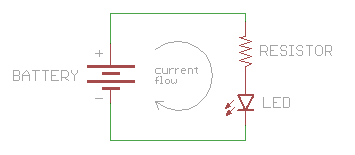What is a Circuit?
Circuit Basics
Voltage and How it Works
You've probably heard that a battery or a wall outlet has a certain number of volts. This is a measurement of the electrical potential produced by the battery, or the utility grid connected to the wall outlet.
All those volts are sitting there waiting for you to use them, but there's a catch: in order for electricity to do any work, it needs to be able to move. It's kind of like a blown-up balloon; if you pinch it off, there is air in there that could do something if it's released, but it won't actually do anything until you let it out.
Unlike air coming out of a balloon, electricity can only flow through materials that can conduct electricity, such as copper wire. If you connect a wire to a battery or wall outlet (WARNING: the voltage in a wall outlet is dangerous, don't do this!), you will be giving the electricity a path to follow. But if the wire isn't connected to anything else, the electricity won't have anywhere to go and still won't move.
What makes electricity move? Electricity wants to flow from a higher voltage to a lower voltage. This is exactly like the balloon: the pressurized air in the balloon wants to flow from inside the balloon (higher pressure) to outside the balloon (lower pressure). If you create a conductive path between a higher voltage and a lower voltage, electricity will flow along that path. And if you insert something useful into that path like an LED, the flowing electricity will do some work for you, like lighting up that LED. Huzzah!
So, where do you find a higher voltage and a lower voltage? Here's something really useful to know: every source of electricity has two sides. You can see this on batteries, which have metal caps on both ends, or your wall outlet that has two (or more) holes. In batteries and other DC (Direct Current) voltage sources, these sides (often called terminals) are named positive (or "+"), and negative (or "-").
Why does every source of electricity have two sides? This goes back to the idea of “potential”, and that you need a voltage difference in order to get electricity to flow. It sounds silly, but you can’t have a difference without two things to be different. In any power supply, the positive side will have a higher voltage than the negative side, which is exactly what we want. In fact, when we measure voltage, we usually say that the negative side is 0 volts, and the positive side is however many volts the supply can provide.
Electrical sources are like pumps. Pumps always have two sides, an outlet that blows something out, and an inlet that sucks something in. Batteries and generators and solar panels work the same way. Something inside them is hard at work moving electricity towards the outlet (the positive side), but all that electricity leaving the device creates a void, which means that the negative side needs to pull electricity in to replace it.*
What have we learned so far?
- Voltage is potential, but electricity needs to flow to do anything useful.
- Electricity needs a path to flow through, which must be an electrical conductor such as copper wire.
- Electricity will flow from a higher voltage to a lower voltage.
- DC voltage sources always have two sides, called positive and negative, with the positive side a higher voltage than the negative side.
The Simplest Circuit
We're finally ready to make electricity work for us! If we connect the positive side of a voltage source, through something that does some work such as a Light Emitting Diode (LED), and back to the negative side of the voltage source; electricity, or current, will flow. And we can put things in the path that do useful things when current flows through them, like LEDs that light up.
This circular path, which is always required to get electricity to flow and do something useful, is called a circuit. A circuit is a path that starts and stops at the same place, which is exactly what we're doing.
Click this link to see a simulation of current flowing through a simple circuit. This simulation requires Java to run.
*Benjamin Franklin originally wrote that electricity flows from the positive side of a voltage source to the negative side. However, Franklin had no way of knowing that electrons actually flow in the opposite direction - at the atomic level, they come out of the negative side and loop back to the positive side. Because engineers followed Franklin's lead for hundreds of years before the truth was discovered, we still use the "wrong" convention to this day. Practically speaking this detail doesn't matter, and as long as everyone uses the same convention, we can all build circuits that work just fine.


